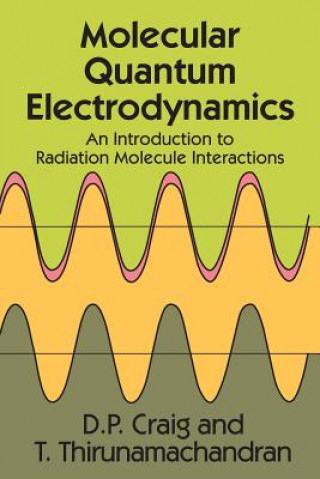
Dostawa
Doradca ds. zakupów
15 648 857 książek w 175 językach







Pokaż wszystkie języki (175)





Jednak się nie przyda? Nic nie szkodzi! U nas możesz zwrócić towar do 30 dni
 Bon prezentowy
O dowolnej wartości
Bon prezentowy
O dowolnej wartości
Bon prezentowy to zawsze dobry pomysł. Obdarowany może za bon prezentowy wybrać cokolwiek z naszej oferty.
Molecular Quantum Electrodynamics
 Angielski
Angielski
 48 b
48 b
30 dni na zwrot towaru
Mogłoby Cię także zainteresować


Preface Chapter 1 Introduction 1.1 The Nature of Electrodynamics 1.2 Maxwell's Equations for the Macroscopic Field 1.3 The Microscopic Field Equations 1.4 The Electromagnetic Potentials 1.5 Lorentz and Coulomb Gauges 1.6 Quantum Mechanics of a System of Charges 1.7 "Classical Electrodynamics, Quantum Electrodynamics and Semiclassical Electrodynamics" Chapter 2 The Electromagnetic Field in Free Space 2.1 The Classical Electromagnetic Field in a Region Free of Sources 2.2 "Electromagnetic Waves in a "Box" 2.3 "Linear, Elliptical and Circular Polarization" 2.4 Lagrangian and Hamiltonian for the Free Field 2.5 The Electromagnetic Field as a Sum of Mode Oscillators 2.6 Quantization of the Harmonic Oscillator 2.7 A System of Oscillators 2.8 Quantization of the Free Field 2.9 Summations Over Wave Vectors and Polarizations 2.10 Uncertainty Relations. Fluctuations of the Vacuum Fields 2.11 Coherent States 2.12 Coherent States as States of Minimum Uncertainty 2.13 Thermal and Chaotic States Chapter 3 Particles and Fields 3.1 Transverse and Longitudinal d-dyadics 3.2 Molecules and Fields: Lagrangian Formulation 3.3 Molecules and Fields: Hamiltonian Formulation 3.4 Instantaneous and Retarded Interactions 3.5 Quantization of the Coupled System 3.6 The Electric Dipole Approximation 3.7 A Higher Approximation Chapter 4 One-Photon Absorption and Emission 4.1 Introduction 4.2 Time Development in a Two-State Model 4.3 Time Evolution and Time-Dependent Perturbations 4.4 An Application: the Steady Perturbation 4.5 Time-Dependent Perturbations Treated by Dirac's Method 4.6 A Discrete State Coupled to a Continuum. The Fermi Golden Rule 4.7 One-Photon Absorption 4.8 The Einstein B-coefficient 4.9 Relaxation of the Number State Assumption 4.10 The Sum Rule for Oscillator Strengths 4.11 Spontaneous Emission and the Einstein A-coefficient 4.12 Stimulated (Induced) Emission 4.13 Magnetic Dipole and Electric Quadrupole Transitions 4.13A Magnetic dipole allowed transitions 4.13B Electric quadrupole allowed transitions 4.13C Interference effects 4.14 Equivalence of Matrix Elements in Minimal Coupling and Multipolar Formalisms 4.15 Calculation of the 2p ? 1s Transition in Hydrogen with the Complete Vector Potential 4.16 Calculation of the Photoionization Rate of Hydrogen with the Complete Vector Potential Chapter 5 Two-Photon Absorption Emission 5.1 Introduction 5.2 Two-Photon Absorption From a Single Beam 5.3 Two-Photon Absorption From Two Beams 5.4 Selection Rules for Two-Photon Absorption and Emission 5.5 Doppler-Free Spectroscopy 5.6 Two-Photon Emission 5.7 Two-Photon Stimulated Emission 5.8 Equivalence of Two-Photo Matrix Elements Chapter 6 Rayleigh and Raman Scattering 6.1 Two-Photo Scattering. The Kramers-Heisenberg Dispersion Formula 6.2 Rayleigh Scattering 6.3 Rayleigh Scattering by Randomly Oriented Molecules 6.4 Raman Scattering 6.5 Raman Intensities 6.6 Stimulated and Inverse Raman Scattering Chapter 7 Interactions Between Molecules 7.1 Introduction 7.2 The Resonance Interaction in Electric Dipole Approximation 7.3 Resonance Interaction in the Minimal Coupling Method 7.4 The Dispersion Energy 7.5 The Wave-zone Limit: Casimir-Polder Potential 7.6 The Near-zone Limit: London Potential 7.7 Dispersion Energy. The Complete Potential 7.8 Interaction Between Permanent Dipoles 7.9 Chiral Discrimination. The Resonance Interaction Between Chiral Systems 7.10 Chiral Discrimination. Discriminatory Dispersion Interactions in the Wave-zone 7.11 Discriminatory Dispersion Interactions in the Near-zone 7.12 Intermolecular Interactions in a Radiation Field 7.13 Radiation-induced Chiral Discrimination Chapter 8 Optical Activity 8.1 Introduction 8.2 Circular Dichroism 8.3 Inclusion of Electric Quadrupole Interactions 8.4 A Two-State Model for Optical Rotation 8.5 Calculation of the Matrix Element for Optical Rotation 8.6 Differential Rayleigh and Raman Scattering of Circularly Polarized Light 8.7 Quadrupole Contributions to Differential Scattering 8.8 Magnetic Circular Dichroism 8.9 The Two-Group Model for Circular Dichroism 8.10 The Two-Group Model for Optical Rotation 8.11 Induced Circular Dichroism Chapter 9 Non-Linear Optical Processes 9.1 Harmonic Generation 9.2 Static Field-Induced Second Harmonic Generation 9.3 Hyper-Raman Scattering 9.4 Selection Rules for Hyper-Raman Scattering 9.5 Laser-Induced Circular Dichroism 9.6 "The Field "Dressing" Approach to Laser-Induced Circular Dichroism" 9.7 Laser-Induced Optical Rotation 9.8 Laser-Induced Resonance Fluorescence 9.9 The Optical Kerr Effect 9.10 Coherent anti-Stokes Raman Scattering (CARS) Chapter 10 Transformations and Multipolar Electrodynamics 10.1 Introduction 10.2 The Electric Polarization Field 10.3 The Magnetization Field 10.4 Partitioning of the Current Density 10.5 The Multipolar Lagrangian 10.6 Atomic Field Equations 10.7 The Multipolar Hamiltonian 10.8 Cancellation of the Intermolecular Interactions in the Multipolar Hamiltonian 10.9 Canonical Transformations 10.10 The Multipolar Hamiltonian by the Canonical Transformation Method 10.11 Equivalence of Matrix Elements 10.12 Canonical Transformation and Perturbation Theory 10.13 The Röntgen Current Chapter 11 Self-Interactions 11.1 Introduction 11.2 Static Self-Energy 11.3 The Transverse Self-Energy of the Free Electron 11.4 Mass Renormalization by Canonical Transformation 11.5 Mass Renormalization in the Multipolar Formalism 11.6 The Lamb Shift 11.7 Lamb Shift Calculated by Canonical Transformation 11.8 Lamb Shift via the Multipolar Hamiltonian Appendix 1 Proofs of Three Identities for Non-commuting Operators Appendix 2 Rotational Averaging of Tensors Appendix 3 Principal Equations Expressed in Gaussian Units Index
Informacje o książce
 Angielski
Angielski




 Jak kupować
Jak kupować






















